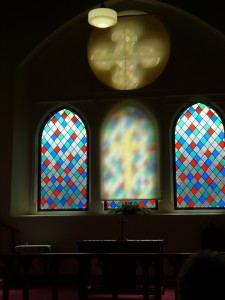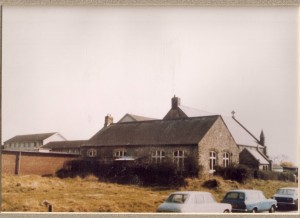On Wednesday 21st October 1741, Charles Wesley ‘came to Caldecot (sic), and preached to a small attentive company of people (at the Cross) on “Blessed are they which do hunger and thirst after righteousness; for they shall be filled.”’ The first Wesleyan Chapel in Caldicot was opened in 1807, when Caldicot was a small agricultural community with a population of about 450. It was a detached building on the north side of Newport Road, where Morgan Travel and Wyedean Wholefoods are now situated. The South Wales Railway opened in 1850 and the improved communications attracted industry. The opening of the Severn Tunnel in 1886 brought many railway workers to the area and the population had more than doubled in 40 years. By the time the chapel was 70 years old it was becomi ng too small and on 9th May 1895 the foundation stone was laid for the present building. It was completed by October 1895 with seating for 280 and a further 250 in the Schoolroom. The old chapel was sold and became a reading room which closed after the First World War when the building was taken over by Cyril Washbourne for use as a cycle shop and, later, a garage. It was demolished to make way for the present shopping centre. The new church was certified as a place for conducting marriages in 1898 and funerals were held at the Church from 1906. In 1932 the Wesleyan Methodists united with the Primitive Methodists and the United Methodists to form the Methodist Church. In Caldicot the United Methodists met at Jubilee Chapel in Chepstow Road, near the Cross, now the site of an Indian takeaway. Despite the Union, the congregations continued to meet separately until Jubilee Chapel closed in the 1960’s. The Church was extended in the 1970’s to give a new kitchen, toilets and a hall, replacing a corrugated iron lean-to which had served these purposes for many years. The inside of the Church was literally turned around during the 1980’s: the organ was dismantled and rebuilt in the opposite corner; the pulpit was altered to just a small one in the corner; the back windows became the front windows; the back wall knocked down and
ng too small and on 9th May 1895 the foundation stone was laid for the present building. It was completed by October 1895 with seating for 280 and a further 250 in the Schoolroom. The old chapel was sold and became a reading room which closed after the First World War when the building was taken over by Cyril Washbourne for use as a cycle shop and, later, a garage. It was demolished to make way for the present shopping centre. The new church was certified as a place for conducting marriages in 1898 and funerals were held at the Church from 1906. In 1932 the Wesleyan Methodists united with the Primitive Methodists and the United Methodists to form the Methodist Church. In Caldicot the United Methodists met at Jubilee Chapel in Chepstow Road, near the Cross, now the site of an Indian takeaway. Despite the Union, the congregations continued to meet separately until Jubilee Chapel closed in the 1960’s. The Church was extended in the 1970’s to give a new kitchen, toilets and a hall, replacing a corrugated iron lean-to which had served these purposes for many years. The inside of the Church was literally turned around during the 1980’s: the organ was dismantled and rebuilt in the opposite corner; the pulpit was altered to just a small one in the corner; the back windows became the front windows; the back wall knocked down and  replaced by a removable partition which could be opened for special services; the porch was enlarged and a new doorway made, and chairs replaced the pews for flexibility. The most recent improvement, the two-storey annexe, was opened in 1996. Extracted from the Centenary booklet written by Peter Strong of Caldicot Local History Society.
replaced by a removable partition which could be opened for special services; the porch was enlarged and a new doorway made, and chairs replaced the pews for flexibility. The most recent improvement, the two-storey annexe, was opened in 1996. Extracted from the Centenary booklet written by Peter Strong of Caldicot Local History Society.



